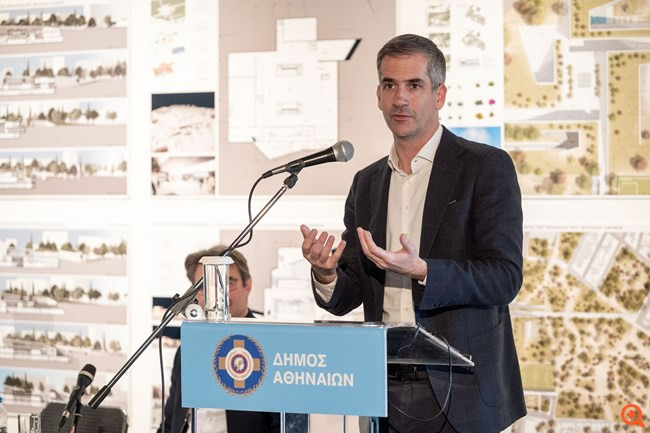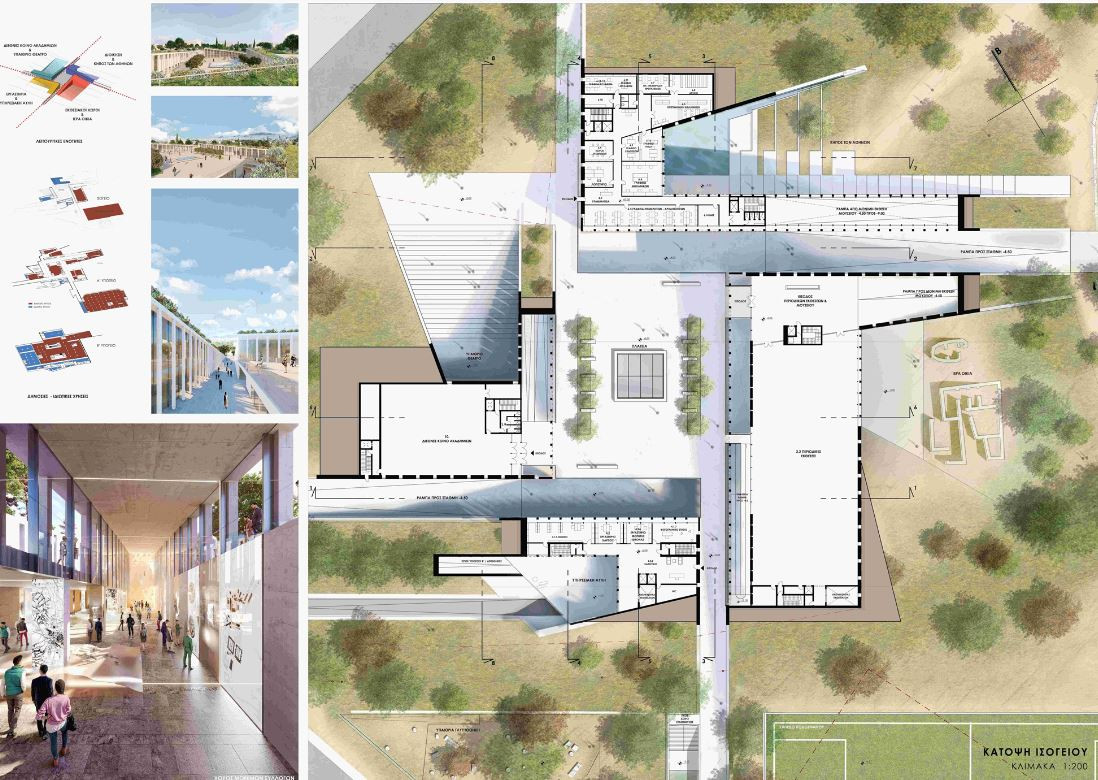The architectural competition was announced last August by the Municipality of Athens through the company “Anaplasi Athens S.A.” in collaboration with the Ministry of Culture.
The country’s first “green” Museum will be created at the Plato Academy – The design that won the open architectural competition was presented today.
All submitted proposals are exhibited until March 19 in an exhibition at the “Melina” Cultural Center of the Municipality of Athens
The plan for the new Museum of the City of Athens at the Platonos Academy, which was awarded in the open Architectural Competition, and will be the country’s first “green” Museum, integrated -in absolute harmony- with the life of one of its most emblematic neighborhoods city, was officially presented today during an event attended by the Minister of Culture and Sports, Lina Mendoni and the Mayor of Athens, Kostas Bakoyannis.
The architectural competition was announced last August by the Municipality of Athens through the company “Anaplasi Athens S.A.” in collaboration with the Ministry of Culture.
The new Museum that was designed will be able to host thousands of unique findings from the excavations carried out by the Ephorate of Antiquities of the City of Athens, in various areas of Athens during the past decades, as well as findings from the excavations of the Metro that today are even in container. Unique objects that will “come to light” and be highlighted in the ideal conditions of a modern Museum.
The team that qualified, receiving the first prize, was that of Architect-Engineer, George Tsolakis. The main criteria considered for the evaluation of the proposals were the architectural approach, the program and functional requirements, the technical approach, the public outdoor environment and the siting of functions in the context of Bioclimatic Planning and Sustainable Development.
Pole of culture, greenery and leisure that highlights the timeless metropolitan role of Athens
The new Museum of the City of Athens is part of the ground-breaking project at the Plato Academy concerning archaeological excavations to reveal an invaluable part of our history, the creation of a park of the future based on the new bioclimatic design, but also the creation of a modern, green Museum of the City of Athens.
The regeneration of the archaeological site and the Grove will contribute to the upgrading of the quality of life of the residents of the area, as they constitute a hyperlocal pole of culture, greenery and leisure in the west of Athens.
Plato’s Academy was considered a suitable place for the construction of the Museum, as a place of spiritual radiation, in which extensive expropriations were carried out from the 1930s by the architect Panagiotis Aristophrons and the Greek State (Ministry of Culture and Environment).
The goal is for the new Museum and the wider space to be an international hub for the development of scientific, artistic and more broadly cultural activities, highlighting the timeless metropolitan role of Athens, from antiquity to the present day.
The Minister of Culture and Sports, Lina Mendoni, in her speech, among other things, emphasized: “With our collaboration with the Municipality of Athens and the Academy of Athens, we are implementing a decades-long vision of the Ministry of Culture, which concerns the promotion of the space where the Plato’s Academy, a grove, a sacred place, evolving into a public place of education and recreation, with great environmental importance for Athens, as well as the creation of the Archaeological Museum of Athens.
It is very important that in this museum the treasures of the bowels of Athens will be exhibited – findings of systematic excavations of at least fifty years – which can change our knowledge, our view, about the history of ancient Greek art.
In the warehouses of the Ephorate of Antiquities of the City of Athens, more than 300,000 antiquities are protected – and with the creation of the museum they will be highlighted – some of which are unique, have never been exhibited and some have not even been published. The findings that will be exhibited are capable of supplementing and perhaps revising our perception and knowledge of the ancient Greek world.
Our basic criterion is to create a museum absolutely friendly to the environment, adapted to the land of Athens, in the area of the Academy, which we want to preserve as a grove in the ancient meaning of the term. A museum with zero environmental footprint.
The two important interventions that we are planning in Athens, the Archaeological Museum of Athens at the Plato Academy and the expansion of the National Archaeological Museum on Patision Street, are those that will overturn the cultural – and not only – physiognomy of Athens, the development footprint of the individual areas , but ultimately also of the capital itself”.
For his part, the Mayor of Athens, Costas Bakoyannis, underlined: “This is a day we have been working for for a long time. Let me say that in this “blackness”, we feel a certain optimism, because today something new is born, something hopeful.
In the archaeological site of Plato’s Academy, “yesterday” coexists with “today” and “tomorrow”. The past with the future.
This space is the “lung” of the neighborhood and at the same time a valuable public space that gives outlets to Athenians of all ages. This alone makes this overall intervention extremely important for the neighborhood and Athens.
The new Museum – based on the award-winning design of Mr. Tsolakis’ team – opens its “embrace” to the city. One can visit the Museum, walk in the park, play in the field and have a picnic and all this together. Because we don’t want museums – fortresses, we don’t want closed museums. We want museums and interventions that are participatory, open.
All that we are happy about, today we achieve thanks to our excellent cooperation. Without egos and entrenchments. We are also very aware that we are only at the beginning. We still have a lot of work ahead of us to secure the necessary funding and move the project forward. Let’s agree, however, that the “omen” are finally good. I would like to extend a big thank you to the Ministry of Culture and Sports and personally to Minister Mr. Mendonis, as well as to the Academy of Athens and the General Secretary Mr. Zerefos, to Anaplasi SA. and Chronis Akritidis, to Mr. Tournikiotis and to the entire Evaluation Committee who shared their wisdom with us.”
In his speech, the Secretary General of the Academy, Professor Christos Zerefos, among others, emphasized: “The Academy of Athens in two different decisions of its Senate, but also today with the presence of mine, we want to welcome this important “leap” which takes place in Athens, in highlighting the concept of the Academy and the ideals of an Academy, which is not a University or a Museum. The Academy is condensed and refined all the human spirit”.
The Managing Director of “Anaplasi SA”, Chronis Akritidis, said: “We are happy because the tender was completed in a short time and with completely transparent procedures. We asked the participants to apply stricter standards than those defined by the gazettes and we were pleased to see that they responded in the best possible way. Thank you to everyone who took part in the competition.”
The head of the jury of the competition, Panagiotis Tournikiotis, for his part, said: “The first prize of the competition is a simple and modern proposal, which will have a special cultural scope. The Museum is inscribed in the natural and residential environment with a dynamic gesture that simultaneously shapes landscape and building. It is organized around a sunken square where four access routes meet, opening it to the city. Its building volumes raise green slopes in physical and visual continuity with the Plato Academy grove, offering an unlimited view of the city. The new Archaeological Museum can be a hyperlocal pole of culture, greenery and leisure in the west of Athens”.
The winner of the architectural competition, George Tsolakis, in his statement, said: “The new Archaeological Museum of Athens projects the vision of the Athens of the future. A public space – museum in harmony with the natural terrain, which will include exhibition spaces, archaeological excavations and multiple recreational and sports spaces, encouraging participation.”
During the event, Professor of Architecture and Urban Planning Dimitris Polychronopoulos presented the architectural study that won the second prize of the competition. The architect-engineer Telemachos Andrianopoulos also presented his own proposal that received the third prize
The specifications of the building – Smaller coverage: 14,362 sq.m. instead of 30,000 sq.m – Zero environmental footprint
The building will be bioclimatic and have a zero environmental footprint, while offering seamless access to people with disabilities.
With the aim of reducing any environmental nuisance, the Municipality of Athens in collaboration with the Ministry of Culture asked the contestants to apply stricter specifications than those defined by the relevant gazettes, ensuring however full coverage of all the needs of the Museum.
The building that will house the Archaeological Museum of the city of Athens will extend over 14,362 sq.m. (including 700 sq.m. for the International Audience of the Academies) instead of 30,000 sq.m. which were foreseen by the building conditions of the relevant gazette (reduced square footage by more than 50%).
The maximum permitted coverage is 20% less than what the Official Gazette stipulated (50% rate instead of 70%) and the height of the building will be 10.5 m, reduced by 7.5 m from what it stipulated The parking lot, which will cover a total of 2,600 sq.m. it will be underground and not open air.
In the surrounding area, the construction of an open amphitheater with 500 seats is planned, while inside the Museum, the building facilities of the “International Audience of the Academies” are included.
At the same time, in the context of the promotion of the Plato Academy by the Municipality of Athens, the regeneration of the green space is planned with the creation of a park in terms of sustainability and sustainability.
Sixteen architectural proposals
Of the 16 valid proposals that were submitted, the first three won cash prizes, while the next two received commendation.
The members of the jury composed by Mr. Panagiotis Tournikiotis (Architect Engineer, NTUA Professor, Chairman of the Committee), Morfo Papanikolaou (Architect Engineer), Penelope Kougianou (Architect Engineer), Nelli Marda (Architect Engineer, NTUA Professor Emeritus) and Alexandros Glentis (Civil Engineer, Representative of the Organizing Authority) . During the competition, data and information were requested from 153 interested parties.
Exhibition at the “Melina” Cultural Center
Meanwhile, until Sunday, March 19, at the “Melina” Cultural Center of the Municipality of Athens, an open exhibition is open to the public, hosting all 16 architectural proposals that participated in the competition.
Source: Skai
I have worked as a journalist for over 10 years, and my work has been featured on many different news websites. I am also an author, and my work has been published in several books. I specialize in opinion writing, and I often write about current events and controversial topics. I am a very well-rounded writer, and I have a lot of experience in different areas of journalism. I am a very hard worker, and I am always willing to put in the extra effort to get the job done.













